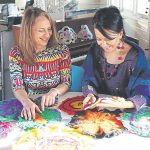A new medical clinic is pioneering a revolutionary procedure combining electro-stimulation and ultrasound to treat everything from diabetic leg ulcers to surgical scars.
The “game-changing” therapy has been proven to aid healing in previously ‘untreatable’ wounds and has never been used in the UK.
It has been clinically proven to dramatically decrease the size and depth of wounds, or completely close them.
Specialists use electro-stimulation and therapeutic ultrasound and modulates them both individually and in combination during the treatment period.
This creates a “micro-circulation” effect, a massage-like process within the tissues and blood vessels of long-term wounds, increasing the blood flow to significantly increase the healing rate.
The therapy will be offered at The London Wound Clinic – the only clinic in Britain to offer the treatment – which opened on Harley Street this week.
BRH therapy is pain-free and non-invasive. It has been proven to significantly enhance the healing rate.
Director of the London Wound Clinic, Mr Yossi Gilbert, who has worked with developers BRH Medical to bring the therapy to the UK, said: “It is very exciting.
“There is nothing else new that is really revolutionary and there hasn’t been for years.
“Both ultrasound and electro-stimulation are well known therapies and have been researched and tried for many years.
“But we have changed things by using the two together. They influence each other and both help with blood circulation.
“We can alter the intensity and frequency to treat different wounds. It is a game-changer.”
The treatment has been used to heal leg ulcers and diabetic foot wounds so far, but Mr Gilbert said that there is no reason why it could not be used for other types of wound.
He added: “There is potential for this to be used for many types of wounds – post-surgical wounds, ischemic ulcers, spinal cord injury and sports injuries, like sprains and ligament damage.
“These are all areas where there is a good possibility that BRH therapy will really help.”
The London Wound Clinic aims to help patients who have suffered long-term debilitation and have lost hope in alternative treatments that will improve their quality of life.
It has been shown to help diabetic foot wounds and leg ulcers heal faster, therefore reducing the associated risk of infection which can result in amputation or death.
Ten percent of the total NHS budget is allocated to the treatment of diabetes and a further five million people are at risk of developing type two diabetes.
The BRH therapy was 100 per cent sucessful in a trial of 21 patients suffering from severe diabetic ulcers which had previously failed to heal.
All the patients’ wounds had either closed or dramatically reduced in size and depth after undergoing four, 30 minute treatment sessions per week for two to 13 weeks.
Renowned medical specialist Dr Yelena Shneiderman, who helped trial BRH therapy, said: “We weren’t very optimistic to use the unknown but decided to give it a try.
“One of our residents suffered enormously for two years from a large, non-healing leg ulcer.
“She had undergone a number of operations, debridements and grafts, with little or no success.
“She became our first patient. Soon her wound started to get smaller and after few months completely closed.
“We are still using the BRH system successfully and are happy to recommend it for the treatment of chronic wounds.”
Hyman Lane, a patient who trialled BRH Therapy, said: “I fell and injured my knee very badly. I was in a lot of pain and my wound was getting worse.
“I was very sceptical about the BRH system at first but seeing the results I have experienced, I can highly recommend using it.”
Another patient, Bella Lawinsky, who had a chronic wound that failed to heal for more than two years, said: “Nothing worked and I lived in terrible pain.
“I was recommended the BRH medical device. My wound has almost closed and I can’t believe how amazing the results have been.”
The London Wound Clinic, with its cutting edge technology and a highly-experienced team, could help thousands of suffers.
Tina Chambers, vice chair of the Tissue Viability Society, said: “Any technology that can assist in the healing of these chronic wounds, and thereby decrease the numbers requiring treatment, will be beneficial not only to the patient themselves, but the healthcare system too.”




